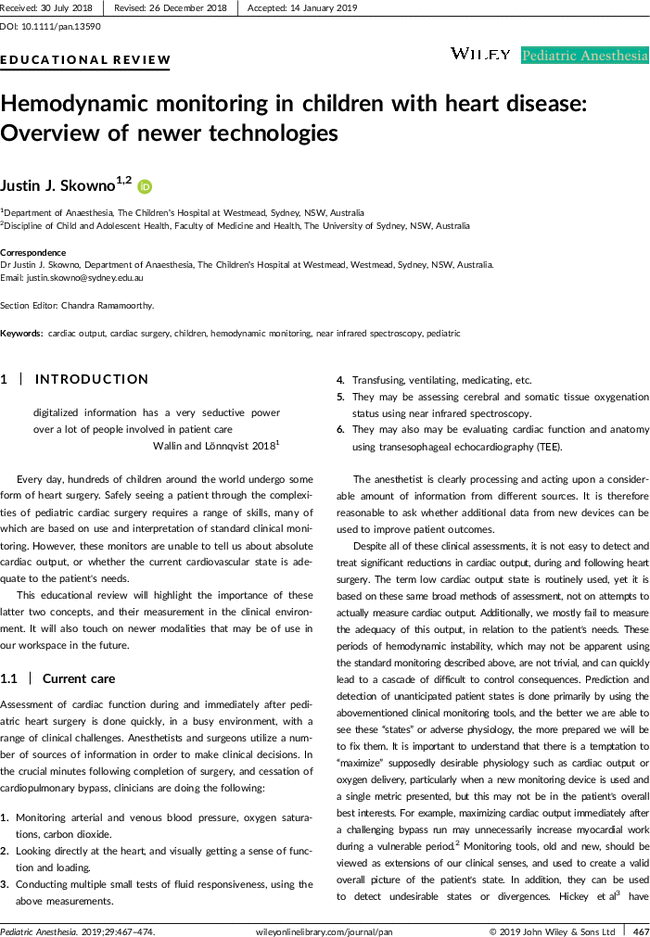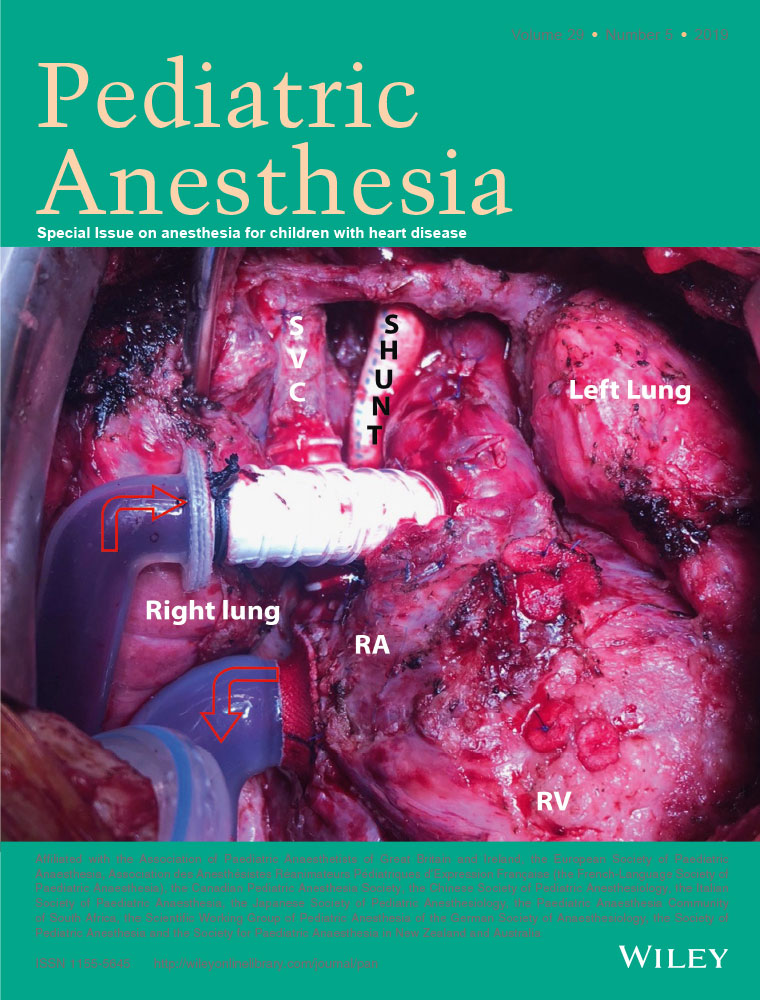Hemodynamic monitoring in children with heart disease: Overview of newer technologies
Corresponding Author
Justin J. Skowno
Department of Anaesthesia, The Children's Hospital at Westmead, Sydney, NSW, Australia
Discipline of Child and Adolescent Health, Faculty of Medicine and Health, The University of Sydney, NSW, Australia
Correspondence
Dr Justin J. Skowno, Department of Anaesthesia, The Children's Hospital at Westmead, Westmead, Sydney, NSW, Australia.
Email: [email protected]
Search for more papers by this authorCorresponding Author
Justin J. Skowno
Department of Anaesthesia, The Children's Hospital at Westmead, Sydney, NSW, Australia
Discipline of Child and Adolescent Health, Faculty of Medicine and Health, The University of Sydney, NSW, Australia
Correspondence
Dr Justin J. Skowno, Department of Anaesthesia, The Children's Hospital at Westmead, Westmead, Sydney, NSW, Australia.
Email: [email protected]
Search for more papers by this author
REFERENCES
- 1Wallin M, Lönnqvist P-A. A healthy measure of monitoring fundamentals!. Pediatr Anesth. 2018; 7: 1-8.
- 2Hosseinpour A-R, van Steenberghe M, Bernath M-A, et al. Improvement in perioperative care in pediatric cardiac surgery by shifting the primary focus of treatment from cardiac output to perfusion pressure: are beta stimulants still needed? Congenit Heart Dis. 2017; 12: 570-577.
- 3Hickey EJ, Nosikova Y, Pham-Hung E, et al. National Aeronautics and Space Administration “threat and error” model applied to pediatric cardiac surgery: error cycles precede ∼85% of patient deaths. J Thorac Cardiovasc Surg. 2015; 149: 496-505.
- 4Saugel B, Malbrain MLNG, Perel A. Hemodynamic monitoring in the era of evidence-based medicine. Crit Care (London, England). 2016; 20(1): 401.
- 5Saugel B, Wagner JY, Scheeren TWL. Cardiac output monitoring: less invasiveness, less accuracy? J Clin Monit Comput. 2016; 30(6): 753-755.
- 6Suehiro K, Joosten A, Murphy LS-L, et al. Accuracy and precision of minimally-invasive cardiac output monitoring in children: a systematic review and meta-analysis. J Clin Monit Comput. 2016; 30(5): 603-620.
- 7Suehiro K, Tanaka K, Yamada T, et al. The utility of intra-operative three-dimensional transoesophageal echocardiography for dynamic measurement of stroke volume. Anaesthesia. 2015; 70(2): 150-159.
- 8Nachman E, Clemensen P, Santos K, et al. A device for the quantification of oxygen consumption and caloric expenditure in the neonatal range. Anesth Analg. 2018; 12: 1-10.
- 9Perak AM, Opotowsky AR, Walsh BK, et al. Noninvasive cardiac output estimation by inert gas rebreathing in mechanically ventilated pediatric patients. J Pediatr. 2016; 177(184–190): e3.
- 10Seckeler MD, Typpo K, Deschenes J, Higgins R, Samson R, Lichtenthal P. Inaccuracy of a continuous arterial pressure waveform monitor when used for congenital cardiac catheterization. Congenit Heart Dis. 2017; 12(6): 815-819.
- 11Narula J, Chauhan S, Ramakrishnan S, Gupta SK. Electrical cardiometry: a reliable solution to cardiac output estimation in children with structural heart disease. J Cardiothorac Vasc Anesth. 2017; 31(3): 912-917.
- 12Beck R, Milella L, Labellarte C. Continuous non-invasive measurement of stroke volume and cardiac index in infants and children: comparison of Impedance Cardiography NICaS® vs CardioQ® method. Clin Ter. 2017; 168(3): e110-e113.
- 13Floh AA, La Rotta G, Wermelt JZ, Bastero-Miñón P, Sivarajan VB, Humpl T. Validation of a new method based on ultrasound velocity dilution to measure cardiac output in paediatric patients. Intensive Care Med. 2013; 39(5): 926-933.
- 14Lindberg L, Johansson S, Perez-de-Sa V. Validation of an ultrasound dilution technology for cardiac output measurement and shunt detection in infants and children. Pediatr Crit Care Med. 2014; 15(2): 139-147.
- 15Saxena R, Krivitski N, Peacock K, Durward A, Simpson JM, Tibby SM. Accuracy of the transpulmonary ultrasound dilution method for detection of small anatomic shunts. J Clin Monit Comput. 2015; 29(3): 407-414.
- 16Michard F, Chemla D, Teboul J-L. Applicability of pulse pressure variation: how many shades of grey? Crit Care. 2015; 19(1): 144.
- 17Han D, Pan S, Wang X, et al. Different predictivity of fluid responsiveness by pulse pressure variation in children after surgical repair of ventricular septal defect or tetralogy of Fallot. Pediatr Anesth. 2017; 27(10): 1056-1063.
- 18Favia I, Romagnoli S, Di Chiara L, Ricci Z. Predicting fluid responsiveness in children undergoing cardiac surgery after cardiopulmonary bypass. Pediatr Cardiol. 2017; 38(4): 787-793.
- 19Gan H, Cannesson M, Chandler JR, Ansermino JM. Predicting fluid responsiveness in children: a systematic review. Anesth Analg. 2013; 117(6): 1380-1392.
- 20Yi L, Liu Z, Qiao L, Wan C, Mu D. Does stroke volume variation predict fluid responsiveness in children: a systematic review and meta-analysis. PLoS ONE. 2017; 12(5): e0177590.
- 21Scott JP, Hoffman GM. Near-infrared spectroscopy: exposing the dark (venous) side of the circulation. Anderson B, Deli MA, Erdoes G, Hammer G, Hardman JG, Lerman J, et al., editors. Pediatr Anesth. 2014; 24(1): 74-88.
- 22Hirsch JC, Charpie JR, Ohye RG, Gurney JG. Near-infrared spectroscopy: what we know and what we need to know–a systematic review of the congenital heart disease literature. J Thorac Cardiovasc Surg. 2009; 137(1): 154-159, 159e1–12.
- 23Ghanayem NS, Hoffman GM. Near infrared spectroscopy as a hemodynamic monitor in critical illness. Pediatr Crit Care Med. 2016; 17(8 Suppl 1): S201-S206.
- 24Davie SN, Grocott HP. Impact of extracranial contamination on regional cerebral oxygen saturation: a comparison of three cerebral oximetry technologies. Anesthesiology. 2012; 116(4): 834-840.
- 25Elwell CE, Cooper CE. Making light work: illuminating the future of biomedical optics. Philos Trans Royal Soc A Math Phys Eng Sci. 2011; 369(1955): 4358-4379.
- 26Mittnacht AJC. Near infrared spectroscopy in children at high risk of low perfusion. Curr Opin Anaesthesiol. 2010; 23(3): 342-347.
- 27Ghanayem NS, Wernovsky G, Hoffman GM. Near-infrared spectroscopy as a hemodynamic monitor in critical illness. Pediatr Crit Care Med. 2011; 12: S27-S32.
- 28Balakrishnan B, Dasgupta M, Gajewski K, et al. Low near infrared spectroscopic somatic oxygen saturation at admission is associated with need for lifesaving interventions among unplanned admissions to the pediatric intensive care unit. J Clin Monit Comput. 2017; 25(10): 166-168.
- 29Gil-Anton J, Redondo S, Garcia Urabayen D, Nieto Faza M, Sanz I, Pilar J. Combined cerebral and renal near-infrared spectroscopy after congenital heart surgery. Pediatr Cardiol. 2015; 36(6): 1173-1178.
- 30Hoffman GM, Ghanayem NS, Scott JP, Tweddell JS, Mitchell ME, Mussatto KA. Postoperative cerebral and somatic near-infrared spectroscopy saturations and outcome in hypoplastic left heart syndrome. Ann Thorac Surg. 2016; 103: 1527-1535.
- 31Rescoe E, Tang X, Perry DA, et al. Cerebral near-infrared spectroscopy insensitively detects low cerebral venous oxygen saturations after stage 1 palliation. J Thorac Cardiovasc Surg. 2017; 154: 1056-1062.
- 32Momeni M, Detaille T, Matta A, Rennotte M-T, Clement de Clety S, Veyckemans F. Cerebral NIRS and superior vena cava ScvO2 should not be compared. Pediatr Anesth. 2012; 22(2): 179-181–authorreply181.
- 33Ricci Z, Garisto C, Favia I, et al. Cerebral NIRS as a marker of superior vena cava oxygen saturation in neonates with congenital heart disease. Pediatr Anesth. 2010; 20(11): 1040-1045.
- 34Skowno J. Correlating cerebral NIRS and superior vena cava ScvO2 in pediatrics. Pediatr Anesth. 2011; 21(4): 463-3.
- 35Kurth CD, McCann JC, Wu J, Miles L, Loepke AW. Cerebral oxygen saturation-time threshold for hypoxic-ischemic injury in piglets. Anesth Analg. 2009; 108(4): 1268-1277.
- 36Kurth CD, Levy WJ, McCann J. Near-infrared spectroscopy cerebral oxygen saturation thresholds for hypoxia-ischemia in piglets. J Cer Bloodflow Met. 2002; 22(3): 335-341.
- 37Kussman BD, Laussen PC, Benni PB, McGowan FX, McElhinney DB. Cerebral oxygen saturation in children with congenital heart disease and chronic hypoxemia. Anesth Analg. 2017; 125: 234-240.
- 38Chan MJ, Chung T, Glassford NJ, Bellomo R. Near-infrared spectroscopy in adult cardiac surgery patients: a systematic review and meta-analysis. J Cardiothorac Vasc Anesth. 2017; 31(4): 1155-1165.
- 39Greenberg S, Murphy G, Shear T, et al. Extracranial contamination in the INVOS 5100C versus the FORE-SIGHT ELITE cerebral oximeter: a prospective observational crossover study in volunteers. Can J Anaesth. 2016; 63(1): 24-30.
- 40Ghosh A, Elwell C, Smith M. Cerebral near-infrared spectroscopy in adults: a work in progress. Anesth Analg. 2012; 115: 1373-1383.
- 41Tweddell JS, Ghanayem NS, Mussatto KA, et al. Mixed venous oxygen saturation monitoring after stage 1 palliation for hypoplastic left heart syndrome. Ann Thorac Surg. 2007; 84(4): 1301-1310; discussion1310–1.
- 42Hoffman GM, Ghanayem NS, Kampine JM, et al. Venous saturation and the anaerobic threshold in neonates after the Norwood procedure for hypoplastic left heart syndrome. Ann Thorac Surg. 2000; 70(5): 1515-1520; discussion1521.
- 43de Oliveira CF, de Oliveira DSF, Gottschald AFC, et al. ACCM/PALS haemodynamic support guidelines for paediatric septic shock: an outcomes comparison with and without monitoring central venous oxygen saturation. Intensive Care Med 2008; 34(6): 1065-1075.
- 44Masuda K, Naito Y, Inoue A. Optimal catheter position for PreSep central venous oximetry catheter. Masui. 2014; 63(2): 128-132.
- 45Iodice FG, Ricci Z, Haiberger R, Favia I, Cogo P. Fiberoptic monitoring of central venous oxygen saturation (PediaSat) in small children undergoing cardiac surgery: continuous is not continuous. F1000Res. 2014; 3: 23.
- 46Baulig W, Béttex D, Bürki C, et al. The PediaSat continuous central SvO2 monitoring system does not reliably indicate state or course of central venous oxygenation. Eur J Anaesthesiol. 2010; 27(8): 720-725.
- 47Park J, Kim J-K, Patil SJ, Park J-K, Park S, Lee D-W. A wireless pressure sensor integrated with a biodegradable polymer stent for biomedical applications. Sensors (Basel). 2016; 16(6): 809.
10.3390/s16060809 Google Scholar
- 48Hubbert L, Baranowski J, Delshad B, Ahn H. Left atrial pressure monitoring with an implantable wireless pressure sensor after implantation of a left ventricular assist device. ASAIO J. 2017; 63(5): e60-e65.
- 49Formenti F, Farmery AD. Intravascular oxygen sensors with novel applications for bedside respiratory monitoring. Anaesthesia. 2017; 72(Suppl. 1): 95-104.
- 50Laussen PC. Landmark lecture on cardiac intensive care and anaesthesia: continuum and conundrums. Cardiol Young. 2017; 27(10): 1966-1973.
- 51Rusin CG, Acosta SI, Shekerdemian LS, et al. Prediction of imminent, severe deterioration of children with parallel circulations using real-time processing of physiologic data. J Thorac Cardiovasc Surg. 2016; 152(1): 171-177.
- 52Ubbink R, Bettink MAW, Janse R, et al. A monitor for Cellular Oxygen METabolism (COMET): monitoring tissue oxygenation at the mitochondrial level. J Clin Monit Comput. 2017; 31(6): 1143-1150.
- 53Bale G, Elwell CE, Tachtsidis I. From Jöbsis to the present day: a review of clinical near-infrared spectroscopy measurements of cerebral cytochrome-c-oxidase. J Biomed Opt. 2016; 21(9): 091307.
- 54Bainbridge A, Tachtsidis I, Faulkner SD, et al. Brain mitochondrial oxidative metabolism during and after cerebral hypoxia-ischemia studied by simultaneous phosphorus magnetic-resonance and broadband near-infrared spectroscopy. NeuroImage. 2014; 102(Pt 1): 173-183.
- 55Bale G, Mitra S, de Roever I, et al. Interrelationship between broadband NIRS measurements of cerebral cytochrome C oxidase and systemic changes indicates injury severity in neonatal encephalopathy. Adv Exp Med Biol. 2016; 923(Chapter 24): 181-186.
- 56Lynch JM, Ko T, Busch DR, et al. Preoperative cerebral hemodynamics from birth to surgery in neonates with critical congenital heart disease. J Thorac Cardiovasc Surg. 2018; 156: 1657-1664.




